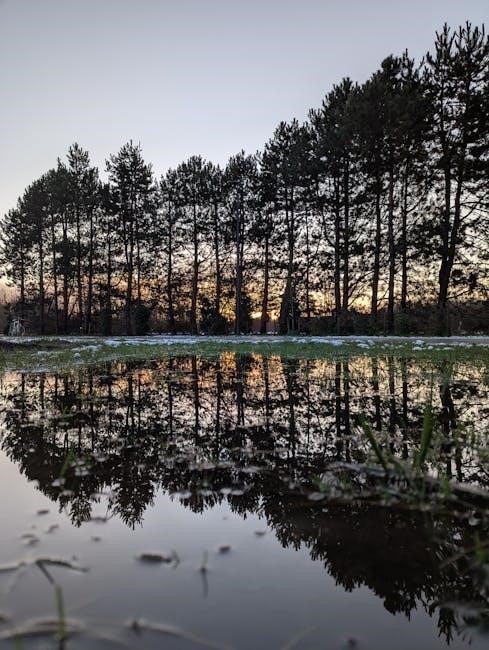In Flanders Fields: A Comprehensive Exploration
In Flanders Fields, a poignant wartime poem, has achieved iconic status within Canadian culture, frequently appearing as a downloadable PDF for study and remembrance.
Historical Context of the Poem
In Flanders Fields emerged from the brutal realities of World War I, specifically during the Second Battle of Ypres in April-May 1915. This conflict witnessed the first large-scale use of poison gas by the German army, inflicting horrific casualties upon Allied troops, including Canadians.
Lieutenant Colonel John McCrae, a Canadian physician serving with the 1st Brigade Canadian Field Artillery, penned the poem following the death of a young soldier, Lieutenant Alexis Helmer, during this battle. The poem’s immediate context was the overwhelming loss of life and the stark landscape of destruction surrounding Ypres, Belgium – a region known as Flanders.
The poem was initially published in the British magazine Punch in December 1915 and quickly gained widespread recognition. Its accessibility, coupled with its powerful imagery, resonated deeply with a public grappling with the immense scale of the war. Digitized versions, often available as a PDF, continue to circulate, preserving its historical significance for future generations.

The Second Battle of Ypres and its Impact
The Second Battle of Ypres, fought in April-May 1915, proved a watershed moment in World War I, and profoundly shaped the context of In Flanders Fields. It marked the first large-scale deployment of poison gas on the Western Front by the German army, causing widespread panic and devastating casualties among Allied forces, including a significant number of Canadian soldiers.
The battle’s intensity and the horrific nature of the gas attacks left an indelible mark on those who experienced it. The landscape itself was transformed into a scene of utter devastation, littered with crosses marking the graves of the fallen. This grim reality directly inspired John McCrae’s poem, capturing the sense of loss and the enduring presence of death.
The battle’s impact extended beyond immediate casualties; it fueled a growing sense of disillusionment and prompted a reevaluation of wartime strategies. Today, historical accounts and analyses, often available as a PDF, detail the battle’s significance and its connection to McCrae’s enduring work.
John McCrae: Author and Medical Officer
Lieutenant Colonel John McCrae, a Canadian physician and soldier, stands as the author of the iconic poem In Flanders Fields. Before becoming a celebrated poet, McCrae served as a medical officer during the Second Battle of Ypres, witnessing firsthand the horrors of trench warfare and the immense suffering of wounded soldiers. His experiences profoundly influenced his writing.
McCrae’s medical duties exposed him to a constant stream of death and devastation, fueling his empathy and shaping his perspective on the war. He wasn’t a professional poet prior to the conflict, yet the emotional weight of his experiences compelled him to express his grief and observations through verse.

The poem, penned in May 1915, quickly gained widespread recognition, solidifying McCrae’s legacy. Today, biographical information about McCrae, including analyses of his life and work, are readily available in digital formats, often as a convenient PDF document for research and study.
Alexis Helmer: The Inspiration Behind the Poem
Lieutenant Alexis Helmer, a young Ottawa soldier, served as a significant inspiration for John McCrae’s In Flanders Fields. Helmer tragically died instantly during the Second Battle of Ypres in 1915, a loss that deeply affected McCrae, who had served with him. Witnessing Helmer’s death amidst the devastation of battle profoundly impacted McCrae’s emotional state and ultimately spurred him to write the poem.

Helmer’s passing served as a stark reminder of the immense human cost of war, prompting McCrae to reflect on sacrifice and remembrance. The poem’s imagery of poppies growing amongst the crosses is often linked to Helmer’s burial site and the countless other fallen soldiers.
Detailed accounts of Helmer’s life and his connection to the poem are frequently compiled in biographical resources, often accessible as a downloadable PDF, offering a deeper understanding of the poem’s origins and emotional resonance.

Analyzing the Poem’s Structure and Themes

In Flanders Fields’ structure and themes, including sacrifice and remembrance, are often explored in detailed analyses available as a convenient PDF document.
Stanza 1: The Battlefield Landscape
The opening stanza of “In Flanders Fields” vividly depicts a scene of devastation and remembrance, a landscape irrevocably altered by the horrors of war. The phrase “In Flanders fields” immediately grounds the poem in a specific geographical location – the Western Front, particularly the Ypres salient in Belgium – a region synonymous with immense suffering during World War I.
The imagery of poppies “blow[ing]” “between the crosses, row on row” is strikingly visual, contrasting the vibrant red of the flowers with the stark white of the grave markers. This juxtaposition highlights the paradoxical presence of life and death coexisting on the battlefield. The repeated “row on row” emphasizes the sheer scale of loss, the countless soldiers who have fallen and are now commemorated by these simple crosses.
Many resources, including detailed analyses available as a PDF, explore how this initial imagery establishes a somber tone and introduces the central theme of sacrifice. The landscape itself becomes a symbol of remembrance, a testament to the enduring impact of war. The stanza’s concise yet powerful language immediately immerses the reader in the poem’s emotional core, setting the stage for the subsequent exploration of grief, duty, and the call to continue the fight.
Stanza 2: The Fallen Soldiers’ Perspective
The second stanza of “In Flanders Fields” shifts the perspective dramatically, granting a voice to the fallen soldiers themselves. They are not depicted as passive victims, but as conscious beings who observe the living world and feel a sense of incompleteness. The line “We are the Dead” is a direct and powerful assertion of their presence, despite their physical absence.
The soldiers acknowledge their inability to experience the beauty of nature – the sun, the moon, the fields of grain – stating, “We shall not see.” This poignant statement underscores the ultimate sacrifice they have made, the loss of future experiences and the simple joys of life. However, their spirit endures, as they express a desire to continue living on through those who remain;
Detailed analyses, often found in PDF format, highlight how this stanza introduces the theme of legacy and the responsibility of the living to honor the fallen. The soldiers’ plea – “To you from failing hands we throw / The torch” – is a call to action, urging the living to carry on the fight for which they died. It’s a powerful moment of transference, a symbolic passing of the torch of freedom and remembrance.
Stanza 3: The Call to Continue the Fight
The final stanza of “In Flanders Fields” delivers a direct and urgent call to action, transforming the poem from a lament into a rallying cry. McCrae implores the reader, “If ye break faith with us who die, / We shall not sleep.” This isn’t a threat, but a solemn warning – a plea for continued dedication to the cause for which they sacrificed everything. The idea of disturbed rest suggests that the soldiers’ peace depends on the fulfillment of their mission.
The stanza emphasizes the importance of upholding the ideals they fought for, and the consequences of failing to do so. The repetition of “In Flanders fields” reinforces the setting as a sacred ground, a constant reminder of the cost of freedom. The imagery of poppies blowing serves as a symbol of both remembrance and the ongoing struggle.
Scholarly interpretations, readily available as a PDF resource, often explore this stanza’s role in wartime propaganda and morale boosting. McCrae’s words weren’t simply about mourning the dead; they were about inspiring the living to persevere, ensuring their sacrifice wasn’t in vain. It’s a powerful and enduring message of duty and remembrance.
Symbolism of the Poppies
The poppies in “In Flanders Fields” are arguably the poem’s most enduring and potent symbol. Historically, the vibrant red flowers flourished in the disturbed earth of battlefields, particularly in the Ypres region of Belgium, where the poem originated. Their unexpected beauty amidst the devastation created a striking contrast, quickly becoming associated with remembrance.
Beyond their historical context, poppies represent several layers of meaning. They symbolize both death and rebirth, a poignant reminder of the lives lost and the hope for a peaceful future. The image of poppies “blowing” suggests a fragile beauty, easily disturbed, mirroring the precariousness of peace.
Detailed analyses, often found in academic PDF documents dedicated to the poem, explore the poppy’s evolution into a symbol of remembrance. Today, the poppy is universally recognized as a tribute to fallen soldiers, worn annually on Remembrance Day. McCrae’s poem cemented this association, transforming a simple flower into a powerful emblem of sacrifice and hope.
Cultural Significance and Legacy
“In Flanders Fields” profoundly impacted Canadian identity, becoming a cornerstone of remembrance; readily available as a PDF, it continues to resonate deeply with generations.
In Flanders Fields as a Canadian Symbol
In Flanders Fields transcends its literary origins, firmly establishing itself as a powerful and enduring Canadian symbol of sacrifice, remembrance, and national identity. The poem’s poignant imagery and heartfelt message deeply resonated with Canadians during and after the First World War, solidifying its place in the nation’s collective consciousness.
Its widespread adoption in commemorative practices, particularly on Remembrance Day, further cemented its symbolic importance. The readily accessible PDF version of the poem has facilitated its inclusion in educational curricula and public readings across the country, ensuring its continued relevance for future generations.
The poppy, central to the poem’s imagery, has become inextricably linked with Canadian remembrance, largely due to the poem’s influence. The poem’s enduring legacy is evident in its frequent appearance on commemorative coins and its recitation by Canadian children, demonstrating its continued power to evoke emotion and inspire reflection on the cost of war. It’s a symbol of national pride and solemn respect.
Remembrance Day and the Poem’s Role
In Flanders Fields holds a central and deeply moving role in Canada’s annual Remembrance Day observances. Each November 11th, the poem is widely recited at ceremonies across the nation, serving as a powerful tribute to the fallen and a solemn call to remember their sacrifice. The accessibility of the poem as a PDF has greatly contributed to its ubiquitous presence during these commemorations.
Many Canadians reflect upon the poem’s eloquent simplicity and profound message during Remembrance Day, connecting with its themes of loss, duty, and the continuation of the fight for peace. Schools frequently incorporate the poem into their Remembrance Day activities, with children reciting it as a poignant expression of respect.
The poem’s verses provide a framework for collective mourning and remembrance, fostering a shared sense of national identity and gratitude. Its enduring relevance ensures that the sacrifices of those who served are never forgotten, and the PDF format allows for easy distribution and widespread participation in this vital tradition.
The Poem’s Influence on Wartime Morale

During the First World War, In Flanders Fields rapidly became a rallying cry, significantly bolstering morale amongst Allied troops and the home front. Its powerful imagery and direct call to action resonated deeply with a public grappling with the immense losses and horrors of war. The poem’s message wasn’t simply one of mourning, but of continuing the fight to honor the fallen – a crucial sentiment during a prolonged and brutal conflict.
The poem’s widespread publication, and now its easy accessibility as a PDF, helped to galvanize support for the war effort. It served as a potent reminder of what was at stake and inspired a renewed commitment to achieving victory. The verses offered solace and a sense of purpose amidst the despair.
While acknowledging the tragedy of war, McCrae’s poem ultimately instilled a sense of determination and resolve, transforming grief into a call for continued sacrifice and unwavering dedication to the cause. Its impact extended beyond the battlefield, shaping public opinion and strengthening national unity.

Adaptations and Recitations of the Poem
In Flanders Fields has experienced countless adaptations and recitations since its 1915 publication, solidifying its place in cultural memory. From musical settings and artistic interpretations to dramatic readings, the poem’s enduring power continues to inspire creative expression. Notably, initiatives like The Vimy Foundation have actively encouraged Canadians, particularly children, to recite the poem, fostering intergenerational understanding and remembrance.
The poem’s accessibility, especially in modern formats like a readily available PDF, has facilitated widespread recitation in schools and at commemorative events. These recitations aren’t merely performances; they are acts of remembrance, honoring the sacrifices of those who served.
Furthermore, the poem’s verses have been incorporated into various wartime memorials and ceremonies, serving as a poignant tribute to fallen soldiers. These adaptations demonstrate the poem’s remarkable adaptability and its continued relevance in contemporary society, ensuring its message resonates with new audiences.

The Poem in Modern Commemoration
In Flanders Fields persists in modern tributes, often shared as a PDF for educational purposes and remembrance, ensuring its message endures for future generations.
In Flanders Fields on Commemorative Coins
In Flanders Fields’ enduring legacy extends to numismatic tributes, notably the 2017 Remembrance Day coin issued by the Royal Mint. Designer Stephen Taylor drew direct inspiration from John McCrae’s poem, translating its solemn beauty onto a circulating commemorative piece.
Interestingly, access to the poem itself is readily available in PDF format online, allowing for detailed study alongside appreciation of the coin’s artistry. The coin serves as a tangible link to the poem’s themes of sacrifice and remembrance, making it a powerful symbol.
The design thoughtfully incorporates elements from the poem, visually representing the poppies blooming amongst the crosses, a direct echo of McCrae’s evocative imagery. This fusion of art and literature provides a unique and accessible way to engage with the poem’s message, even for those unfamiliar with the original text, often found as a downloadable PDF.
Children Reciting the Poem for Remembrance Day
A powerful initiative, inspired by The Vimy Foundation’s centennial work, involved Canadian children reciting In Flanders Fields for Remembrance Day ceremonies. This project aimed to connect a new generation with the poem’s profound message of sacrifice and remembrance, ensuring its continued relevance.
The poem, widely accessible as a PDF document for educational purposes, became a focal point for classroom learning and commemorative events. Hearing children deliver McCrae’s verses adds a particularly poignant layer to Remembrance Day observances, emphasizing the future entrusted to those who served.
These recitations weren’t merely rote memorization; they were opportunities for children to grapple with the poem’s themes and understand its historical context. Many schools utilized the readily available PDF version to facilitate discussions and analyses. The act of reciting fosters a deeper connection to the past and a renewed commitment to peace, ensuring the poem’s legacy endures.
The Poem’s Enduring Relevance Today

Even as Remembrance season fades and symbolic poppies are carefully stored away, In Flanders Fields continues to resonate deeply, prompting reflection on sacrifice and the cost of conflict. Its message transcends its historical context, speaking to universal themes of loss, duty, and the hope for peace.
The poem’s accessibility, particularly through widely circulated PDF versions, ensures its continued study and appreciation. It serves as a powerful reminder of the human cost of war, prompting ongoing dialogue about conflict resolution and the importance of remembrance.
Today, In Flanders Fields isn’t simply a historical artifact; it’s a living testament to the courage and resilience of those who served. The readily available PDF format allows for easy sharing and study, ensuring that McCrae’s words continue to inspire generations to strive for a more peaceful world, honoring the fallen and advocating for a future free from conflict.
